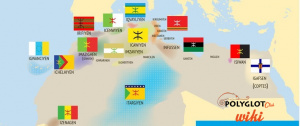Language/Kabyle/Vocabulary/Dining-out
Vocabulary
In this lesson, you will learn Kabyle vocabulary related to dining out, such as restaurant, menu, and ordering food.
Dining Out
Here are some key phrases and words related to dining out in Kabyle:
| Kabyle | Transcription | English |
|---|---|---|
| ttaṛa | tta-ra | restaurant |
| deg-yefren | deg-yefren | in a hurry |
| nelli | nelli | today |
| axxam | axxam | menu |
Making Reservations
If you want to make a reservation at a restaurant in Kabyle, here are some common phrases:
- Tura-d ttaṛa, s ḥan-kem || Please book a table for us
- Tura-d ttaṛa, teffa-kem || Please reserve a table for us
- A sdiḍ nesla ttaṛa, s ḥan-kem. || We would like to book a table.
Ordering Food
When you are ready to order your food in Kabyle, here are some key phrases and words:
| Kabyle | Transcription | English |
|---|---|---|
| Ur nesleḍ ara. | Ur nesleḍ ara | We are not ready yet. |
| Ur yelli ara. | Ur yelli ara | I am not hungry yet. |
| a sliḍ umessas merra deg wacu. | We'll take a few minutes to decide | |
| erbḥen | erb-ḥen | appetizers |
| aṭberkatin | aṭber-ka-tin | starters |
| tagarest | ta-ga-rest | soup |
| isaffen | i-saf-fen | salads |
| akouran | ak-ou-ran | meat dishes |
| aghrum | a-ghrum | chicken dishes |
| imahal | i-ma-hal | seafood |
| azegrar | a-ze-grar | pasta |
| aghrum iwumamen | a-ghrum i-wu-ma-men | vegetarian dishes |
| aslal | a-sla-l | desserts |
Asking for the Bill
When you are ready to pay the bill in Kabyle, here are some common phrases:
- Meniḍ-ak aseqsay || The check, please.
- Aseqsay-ik || Your check.
- Ula d-kem-d da, aseqsay-ik || And for you, your check.
- Llant ttaṛa, at-tennaḍ s-yisallen || We would like to pay, please.
Cultural Information
- Eating Habits ###
Kabyle cuisine reflects the culinary traditions of the region, with a focus on fresh ingredients and simple but flavorful dishes. Kabyle people tend to eat a large meal at midday and a smaller meal in the evening.
Families often eat together and share dishes, and it is common for guests to be served a variety of dishes as a sign of hospitality. Bread, particularly flatbread called khobz tabouna, is a staple of the Kabyle diet and is often eaten with soups or stews.
- Tipping ###
Tipping is not an established practice in Kabyle culture; it is not expected, but it is appreciated. If you choose to tip, you can leave a small amount of money on the table or round up the total amount of the bill.
- Popular Kabyle Dishes ###
Here are some popular dishes you may encounter when dining out in Kabyle:
- Chtitha Djedj (chicken with chickpeas and onions)
- Couscous (semolina served with meat and vegetables)
- Koucha (lamb liver cooked with onions and spices)
- Loubia (white bean stew with meat)
- Merguez (spicy lamb or beef sausage)
- Rechta (flat noodles with a meat and vegetable sauce)
- Shorba (a hearty vegetable soup)
- Dining Out in Kabyle ###
When dining out in Kabyle, it is important to know that restaurants often operate on a different schedule than other businesses. Many restaurants close in the mid to late afternoon and reopen in the evening. It is also common for restaurants to close one or two days per week, typically on Mondays or Tuesdays.
Reservations are not always necessary, but they are recommended for popular restaurants or during peak times. When you arrive at the restaurant, wait to be seated, as it is not typical to seat yourself.
Kabyle cuisine is typically not very spicy, but may be seasoned with a variety of herbs and spices. Be sure to ask your server if you have any dietary restrictions or preferences, as many traditional dishes feature meat or poultry.
- Conclusion ##
In this lesson, you learned Kabyle vocabulary related to dining out, such as restaurant, menu, and ordering food. You also gained some insight into Kabyle eating habits, tipping practices, and popular dishes. With these skills, you will be better equipped to navigate dining out experiences in Kabyle-speaking regions.
Related Lessons
- Ordinal numbers
- Modes of transportation
- Count to 10
- Feelings and Emotions
- Food
- Days of the Week
- How to Say Hello and Greetings
- Food items
- Relationships
Sources

